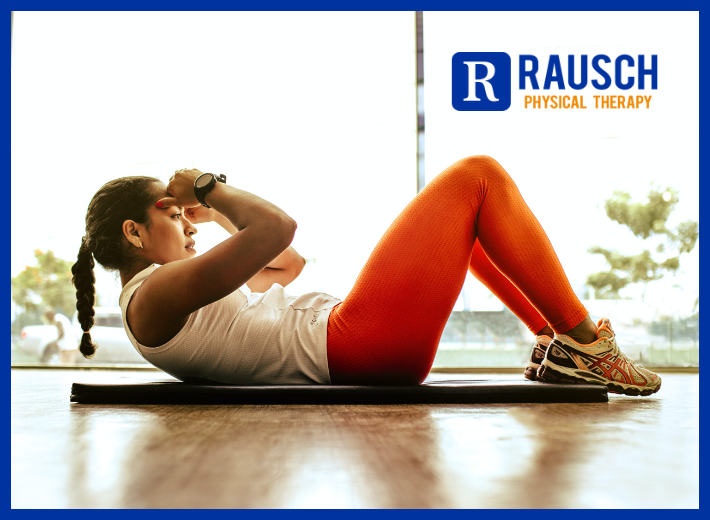Balancing a healthy diet and a consistent exercise routine can often feel like a complicated equation, but successful healthy living is truly about synergy, not sacrifice. The key to long-term,
Exercise During Your Period And Each Stage Of Your Cycle
March 1, 2023 1:03 pm / Category: Rausch Physical Therapy

If you have a period, it’s likely you’ve experienced some of the negative side effects. There is no medical reason to avoid working out during menstruation or any other phase of your cycle. In fact, exercise may be beneficial for easing some common symptoms like cramps and emotional distress. To work with and not against our bodies, learn more about the phases of the menstrual cycle and how it connects to exercising.
There’s a common belief in the fitness world that regardless of gender, results are only gained with consistent hard work.
However, due to gender bias within the field of exercise science, most research on effective exercise programming is done on male test subjects.
Exercise recommendations are made as one-size-fits-all prescriptions, and women in all life stages optimistically attempt the latest workout trend to gain positive results.
The pressure to maintain a certain body shape is at the forefront of many women’s workout intentions. Yet, at some point in the month, the “always work hard” attitude comes in direct conflict with low energy days, and women can fall victim to their own negative judgment.
As a personal trainer and lifelong exerciser, I’ve gained a new perspective when it comes to exercise and the menstrual cycle. By gaining an understanding of our monthly hormonal fluctuations, we can ramp up our workouts when our bodies are ready for it, and turn down the intensity when our bodies can’t tolerate as much of a physical load.
When we learn how to cycle our exercise with our cycle, we’re using our female biology to our advantage — working smarter, not harder.
To work with and not against our bodies, we must first have a keen awareness of the phases of the menstrual cycle.
A menstrual cycle averages 23–38 days and comprises 3 phases.
The follicular phase
The follicular phase begins on day one of your period, and it’s characterized by the lowest levels of female hormones throughout the month. Because sex hormones are low, this is when the female body is most similar to that of a man.
The follicular phase continues 5–6 days past the last day of your period, lasting 12–14 days. Following your period, estrogen gradually increases, resulting in the release of luteinizing and follicle-stimulating hormones, culminating in mid-cycle ovulation.
Ovulation
Ovulation is when your body releases an egg, and if sperm is present, this is the golden opportunity for implantation and pregnancy to occur. In a 28-day cycle, ovulation occurs right around the midpoint, often close to day 14.
The luteal phase
The luteal phase occurs right after ovulation and lasts for the second half of your cycle, bringing with it the hormonal parade.
At this point, estrogen has a moderate second rise, but more importantly, progesterone enters the picture and brings a number of physiological symptoms along with it.
The luteal phase ends when progesterone peaks, and if you’re not pregnant, both estrogen and progesterone drop and signal to your brain to start your period and begin a new cycle.
Now that we have a basic understanding of the hormonal changes that define the menstrual cycle, let’s talk more about the physiological changes that can affect your exercise efforts.
The first part of your cycle, known as the follicular phase, is the low hormone phase, and the only cycle symptoms you’re likely experiencing are those of your period.
If you’re trying to exercise hard, it’d make sense that this is the time of the month to put your best efforts forth, as you have no hormonal symptoms complicating things.
The event of ovulation can be marked by a slight rise in a woman’s temperature. This doesn’t seem like a big deal on the thermometer, but it’s important to know that this temperature increase continues past ovulation and lasts the duration of the second half of your cycle.
Given the raised temperature during the luteal phase, the female body is more sensitive to exercising in hot or humid environments (think hot yoga, being in a warm gym, or running outside on a hot summer day), and athletic performance can really take a hit.
Aside from raising your core temperature, progesterone increases your resting heart rate and breathing rate. All three of these symptoms can be interpreted as additional strain on the body, especially when exercising, leaving a woman to feel like she’s having to work harder than usual.
Another characteristic of progesterone is its catabolic effect, meaning that this hormone likes to break tissue down.
This is important when it comes to strength training during the second half of your monthly cycle.
Under ordinary circumstances, strength exercises require a load to work against — bodyweight, bands, cables, free weights — that creates a tension response within the worked muscles.
Muscular tension from repetitively lifting a challenging load leads to microscopic tears within your working muscles. Your body then heals these microscopic tears by regrowing the muscle tissue, resulting in bigger and stronger muscles.
When progesterone is present during the second half of the menstrual cycle, it can reduce this protein regrowth, negatively affecting the process of muscle repair.
Just a few simple habits can make a big difference when it comes to syncing your workouts with your cycle.
Tracking your cycle
If you want to improve your exercise efficiency in conjunction with your menstrual cycle, the first requirement is to track your cycle.
It’s as easy as keeping a digital thermometer and an alarm clock by your bed. Every morning when you wake up (waking up at the same time each morning is important for this method), before you do anything (don’t get out of bed or even take a sip of water), take your temperature and write it down.
This is especially important during the first half of your cycle, so you can have an understanding of what your waking temperature is. By writing it down every morning at the same time, you’ll be able to see a small increase in your temperature around mid-cycle, indicating ovulation has taken place.
Tracking your menstrual cycle will eliminate guesswork and provide you the ability to anticipate what your body is willing to tolerate.
Note that if you’re on birth control, which can work by preventing ovulation, this method of tracking your cycle might be more difficult.
Choose different exercise at different times of the month
- Follicular phase. This is when you can HIIT it hard (see what I did there!). Get your high intensity interval training, powerlifting, heavy weight lifting, plyometrics, long runs, hot yoga, hill repeats, or other intense exercise modalities in now. Take at least one rest day between hard workouts, and be mindful of signs of overtraining, as some studies suggest you may be more prone to muscle damage from overtraining during this phase.
- Luteal phase. This is when to respect your body’s high hormonal load. Moderate cardio (no breathless intervals), outdoor walks and hikes, strength training (low to moderate weight and higher reps), yoga, and Pilates are all great choices. This is a good time to work on enhancing your mobility, and make sure to stay away from hot workout environments.
Work with your body, not against it
Exercise research and recommended protocols rely heavily on data that has used male subjects, as they don’t have the monthly hormone fluctuations that women do.
As a result, women attempt to implement exercise programs that aren’t constructed with female biology in mind, leaving them to wonder where they went wrong when their energy changes.
Through knowledge of their menstrual cycle phases and tracking their cycles, women will be empowered by gaining control of their exercise efficiency while avoiding failed workouts and self-criticism.
Be strong. Be flexible. Be healthier with physical therapy! Don’t waste any more of your time in pain. Contact our team today at 949-276-5401. To get health and wellness updates and learn about what we have to offer ongoing, join our Facebook community.
Reference: [https://www.healthline.com/health/fitness/female-hormones-exercise#Phases-of-the-menstrual-cycle]






